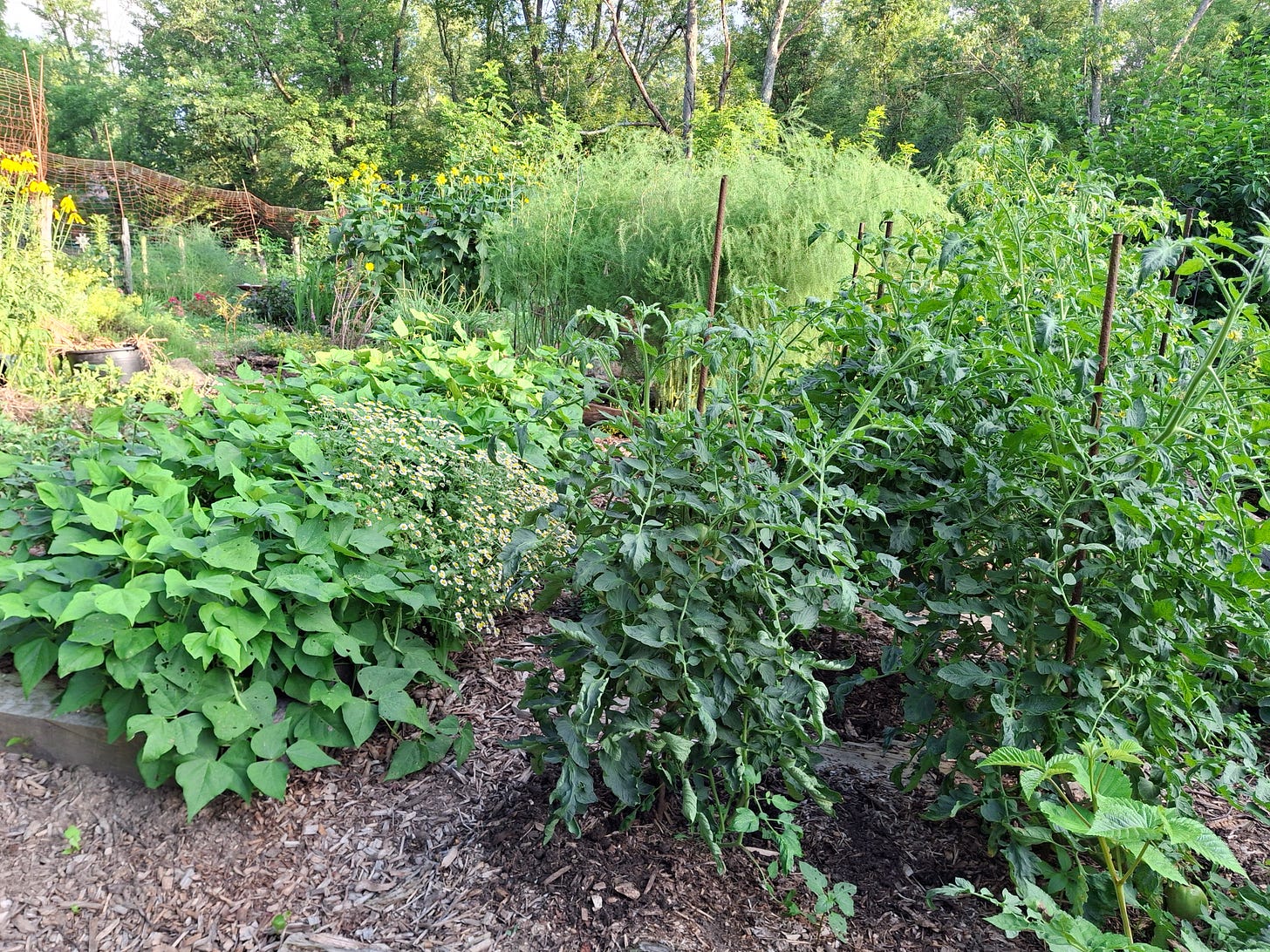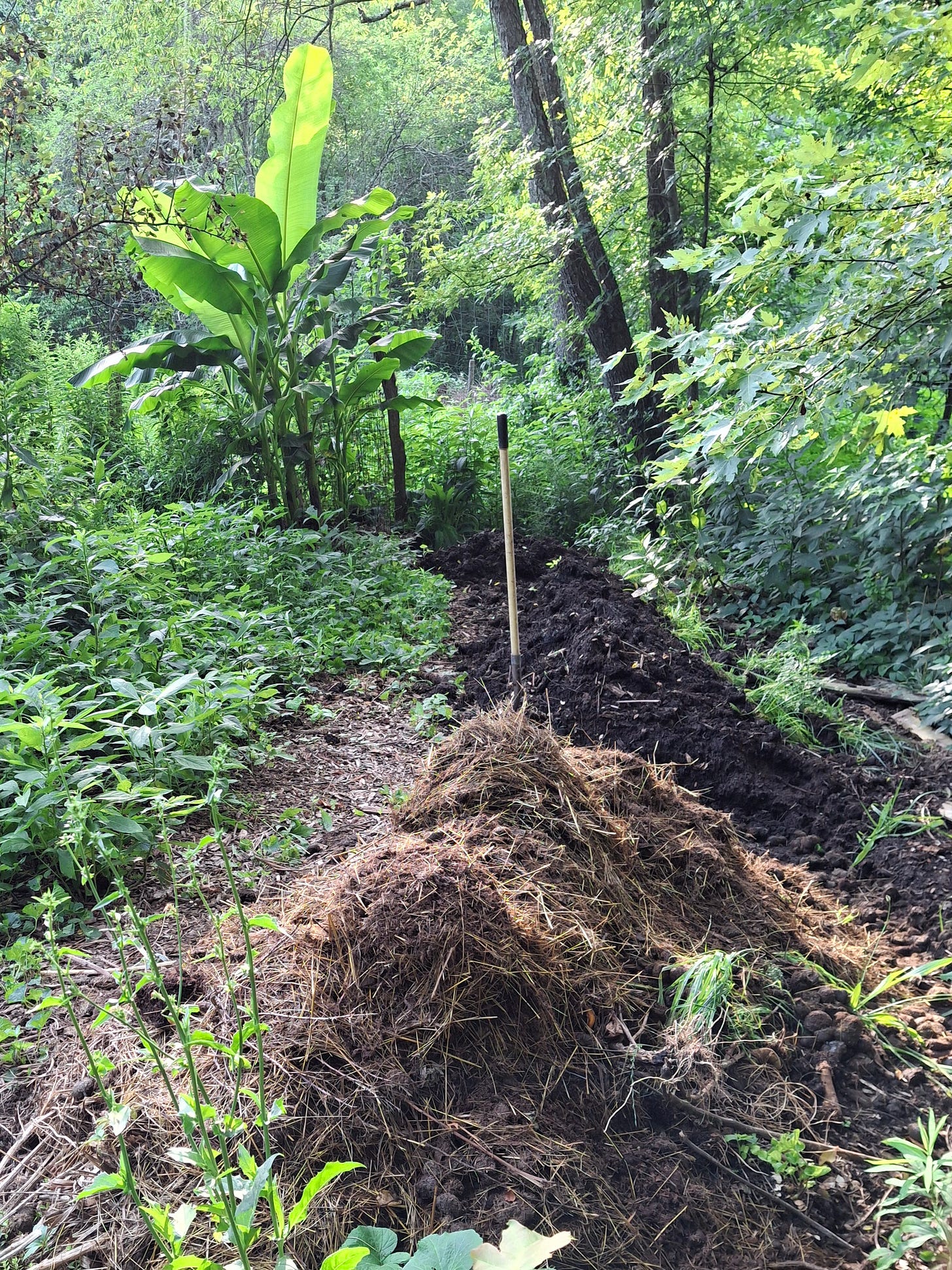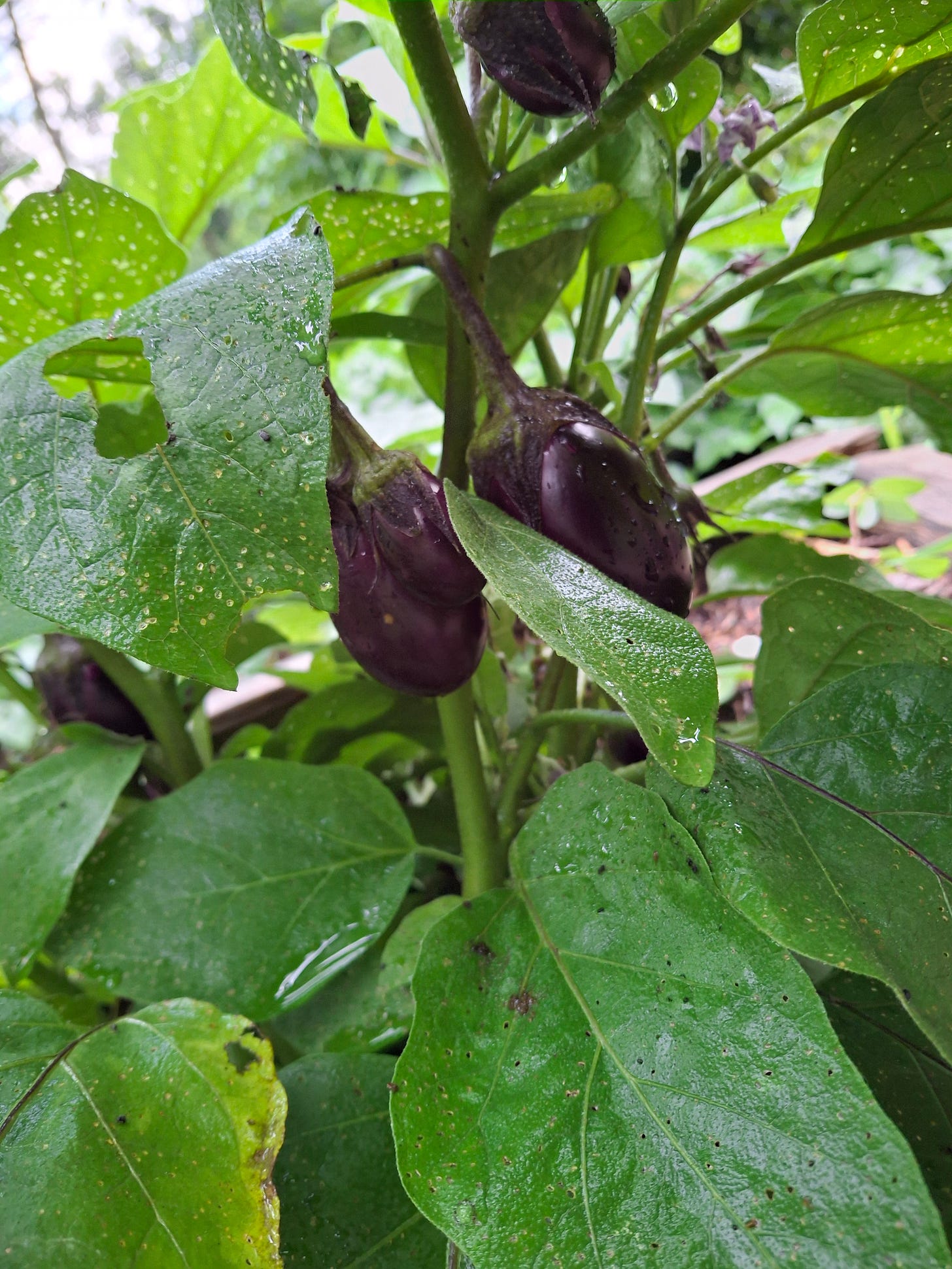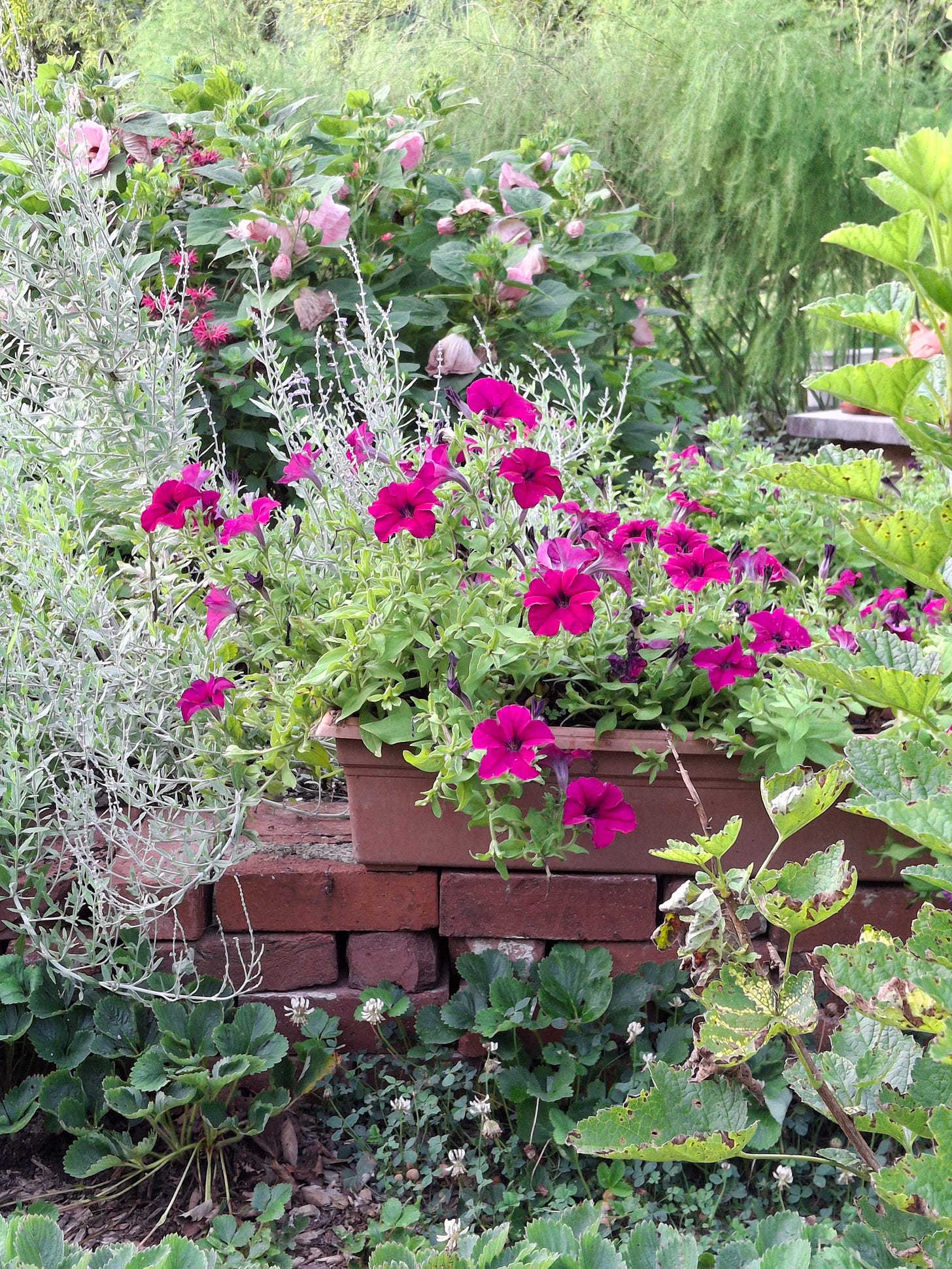Tomatoes and beans love the heat
Mid-July arrives with dry spells, severe thunderstorms, and soaring temperatures. The specifics vary year to year, but we can always expect some sort of extreme weather this time of the season. On many days it has been too hot to spend time in the garden midday, so I've tried to squeeze all the tasks into early morning and evening. Oppressive heat was followed by two evenings of downpour that tragically arrived just when I got home from work and lasted until after dark.
A quick walk under the umbrella at dusk revealed a lush carpet of crabgrass on the paths, but also lots of veg ready to be picked. The garden might not look as tidy as I would like, but plants are surviving and producing. With planning and preparation I’ve succeeded in creating a garden tough enough to get through the second half of summer without lots of attention from me. Here are my tactics.
Build better soil with organic matter
Constantly improving your soil with the addition of compost and mulch is probably the most important action you can take to create a resilent garden. A healthy, living soil rich in organic life makes plants better able to deal all challenges, including the ability to withstand both drought and downpour. Soil organic matter magically improves both moisture retention and drainage, and generous layer of mulch protects from pounding rain.
Conveniently, spreading mulch and compost can be done any time, even in the off-season when there are few garden chores. I spend time from late fall to early spring mining garden paths for topsoil to spread on beds, renewing the wood chip mulch in paths, and digging up finished compost beds for spreading.
The compost is more of a windrow than a pile
Recently a video caught my eye of a woman sifting compost with the caption, “Work smarter, not harder.” She was indeed working quite hard, but ironically the intended message was that you should buy the sifter to save work, rather than simply stop sifting. This raises the question, why sift at all unless you need a very fine soil for tiny seeds? Sifting compost is totally unnecessary otherwise, and it's perfectly okay to use compost that is still a bit chunky and not totally finished. Right now I'm spreading just such a product on my tomato and eggplant beds where it acts as a very nutritious mulch.
The sifter video is a reminder that there are legions of vendors out there trying to sell nifty gadgets to novice gardeners. These gizmos can be fun and occasionally useful, but are rarely absolutely necessary and are mainly designed to separate you from your money.
Grow from hybrid seed
This suggestion runs counter to gardening wisdom that advises growing heirloom plants. These older varieties have been passed down through generations and often have superior flavor or texture. Growing such plants allows you to save seeds, knowing they will reliably produce similar plants next year. I'm certainly not advising anyone to give up on heirloom plants. To the contrary, I believe it is important to preserve the genetic diversity embodied in these plants and to reduce being dependent on yearly seed purchases.
That being said, I also feel there is no shame in buying hybrid seeds or plants, especially for novice gardeners. Hybrid plants are often bred with disease resistance in mind, especially the blights and wilts that strike this time of year. Hybrid plants sail on unscathed while heirlooms succumb. My heirloom zucchini ‘Costata Romanesco’ has produced a total of one edible fruit, the others rotting on the vine, while the hybrid summer squash ‘Smooth Criminal’ pumps out fruit like there is no tomorrow.
‘Patio Baby’ eggplant, one of my favorite hybrids
Heirlooms can gradually be worked in after experimentaton to discover which ones perform well under local conditions. Meanwhile, there is nothing wrong with growing hybrids. This allows you to obtain a yield while gaining knowledge and experience.
Stop growing in pots
Obviously this advice isn't for those whose only option is container growing. A patio or balcony container garden can provide beauty, a peaceful hangout spot, and of course herbs and veg. If I had limited space you can bet I would fill it with pots of all sorts.
There seems to be a trend even among gardeners with plenty of space to use pots or large containers, however, ostensibly to cut down on maintenance tasks like weeding. Keeping containers weed-free is easier than maintaining a garden in-ground, but pots create other problems, mainly the need for supplemental water and fertilizer.
After weeks of steeling myself at work before walking past tables full of gorgeous annuals, I finally succumbed to temptation and went home with a flat of petunias, gazania, and dwarf zinnias. Now I have pots that must be watered daily or they will wither in summer's heat. Not only water but regular inputs of fertilizer are necessary to keep them at their peak.
I fell hard for these petunias
Currently I have tomatoes, green beans, and eggplants in the ground that have never been watered or fertilized since their planting. They are sustained by rainwater and the rich soil in which they grow, plus some top-dressing with compost as described above. These in-ground beds just need to be checked now and then and harvested when necessary, but otherwise they do fine on their own because they are free to develop large root systems. In case of an emergency preventing me from visiting the garden for several days, these plants would do fine.
Integrate perennials when possible
Some of the advice I regularly come across says to plant perennials to save the time and effort of yearly planting, claiming that in a cost/benefit analysis, perennials outperform annuals by delivering more produce with less work. After spending the week trying to get my black raspberries under control, I tend to question this wisdom. I've also spent an inordinate amount of time over the years pruning fruit trees and hauling away the brush, and can attest that perennial crops often require lots of labor.
Space is another consideration. Perennial crops like asparagus, berry canes and bushes, and small fruit trees do indeed only need to be planted once, but they usually produce one big harvest (“everbearing” berries can provide a second one) then just take up space for the remainder of the season. If you include the large amount of space required in the ratio, the benefit side goes south.
Despite perennials not being the panacea they are often made out to be, they have huge benefits and I heartily recommend them, especially smaller ones that can be tucked here and there. Planted between annual crops they can help hold soil in place and act as windbreaks, mitigating the effects of violent storms. The shade they provide makes working in the garden bearable on sunny days, as long as I stay in certain areas.
Perennials attract all manner of wildlife including pollinating insects and many species of birds and butterflies. Snakes and toads find homes in the season-long cover they provide. By nurturing these members of the animal kingdom, perennial plants creat a diverse and healthy garden ecosystem that keeps less benign insects in check.
Perennials in April
While perennial plants — at least in my temperate region — don't usually have a long harvest period, they vastly extend the growing season as far as greenery and flowers are concerned. Ornamentals and herbs pop up in early spring and grow quickly, breaking up what would otherwise be a boring expanse until late spring and making the garden an exciting place to visit. If I relied exclusively on annuals I would wait weeks before much happened out there, so for me there is distinct psychological advantage to growing perennials. I spend many hours in April and May enjoying their progress.
Later in the season when the annuals catch up and begin pumping out food, the perennials are still there blooming, attracting bees, butterflies, and hummingbirds, and in general making it a place where I want to spend as much time as possible. Each time I visit the garden I do small chores that make for a healthier garden such as pruning dead or diseased plant matter, cleaning up debris, and harvesting mature vegetables so plants keep producing.
Spending maximum time when conditions allow means a more resilient garden when little time can be spent. In fact, my garden wouldn't be anything near what it is is if I didn't spend so much time there in the off-season pruning and prepping and mulching. If perennials did nothing but entice me to the garden they would be well worth it.
For everyone who has made it this far, here's a video of insects on cup plant. It garnered not a single like on Notes, which as everyone knows is full of philistines. I'm sure my readers will appreciate it.









It certainly has been an interesting season so far, especially compared to last year. Weeding has been quite a chore, but it feels good to set the vegetable plants free from competition and neaten up the rows. It's all at the tipping point...needing more time to can and freeze and otherwise preserve food, and spending less time pulling weeds.
Hi Lynn, great post. How do I know if my compost is ready? Thoughts on this?